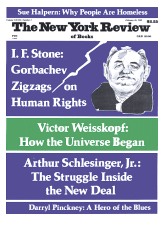In response to:
Mind-Reading from the September 29, 1988 issue
To the Editors:
Israel Rosenfield’s review of The Oxford Companion to the Mind [NYR, September 29] is a splendid commentary on the book’s articles about linguistics and the structure and function of the brain. As Rosenfield points out, most of the book’s articles on the paranormal admirably reflect the skepticism of an overwhelming majority of psychologists, but readers should be alerted to two articles in this area that should never have been commissioned. Indeed, their inclusion reveals a singular lack of judgment on the part of the book’s two editors.
I refer to the entries “Astrology” and “Paranormal Phenomena and the Unconscious.” Both are by Colin Wilson, England’s leading journalist of the occult, and a firm believer in ghosts, poltergeists, levitations, dowsing, PK (psychokinesis), ESP, and every other aspect of the psychic scene. After dismissing classical astrology as pseudoscience, in his four-column entry on astrology, Wilson goes on to defend what he calls “astrobiology”—the view that positions of the sun, moon, and planets strongly influence human personality and behavior. He praises the studies of Michel Gauquelin which correlate a person’s choice of profession with the positions of planets at the time of birth. Wilson is persuaded that this correlation is mediated by the earth’s magnetic field. He believes that dowsing is successful because arm muscles “react to weak changes in terrestrial magnetism caused by underground water.”
Although dozens of recent studies have exploded the myth that a full moon causally influences psychotic behavior, Wilson cites none of those studies. Instead, he refers to research purporting to show that the “electrical potential between the head and chest is greater in mental patients than in normal people, and increases at the full moon.” Someone in Tokyo, Wilson adds, has correlated sunspot activity with the rate at which “albumin curdles in the blood,” and “rises before dawn, as the blood responds to the rising sun.”
These and other “medical facts,” Wilson asserts, provide a foundation for astrobiology, though he admits it is not yet clear how terrestrial magnetism can “influence a human being to the extent of predisposing him to one profession or another.” He is convinced that our ancient ancestors, back to Cro-Magnon man, had a knowledge of astrobiology that later degenerated into traditional astrology.
Wilson’s five-column article on the paranormal and the unconscious is comparable rubbish. He defends the view that the unconscious is the source of PK—the mind’s ability to levitate tables and generate the poltergeist phenomena of haunted houses. As evidence for PK he cites the little miracles performed by Nina Kulagina, the Uri Geller of the Soviet Union, and the fact that Felicia Parise, a friend of American parapsychologist Charles Honorton, once moved a plastic pill bottle across her kitchen counter. Honorton’s videotape of this great event suggests that she had an invisible thread stretched between her hands as they inched forward on both sides of the bottle. She has never repeated the trick. Wilson mentions the theory of British physicist John Taylor that PK forces are electromagnetic, but he fails to say that Taylor later repudiated both this conjecture and the reality of PK.
Wilson believes that psi powers reside in the right side of the brain, and that the self is actually a “ladder of selves” with our consciousness at the bottom rung. The higher selves possess awesome paranormal powers that are becoming stronger as the race evolves. He ties all this to the philosophy of Edmund Husserl, and recommends that all parapsychologists take a course in Husserlian philosophy.
Why the editors would have asked England’s wildest occultist to write two lengthy articles for an otherwise praiseworthy encyclopedia passes all comprehension. As one reviewer put it, “This is like letting a creationist write an appreciation of Darwin for a scientific review volume on evolution.”
Martin Gardner
Hendersonville, North Carolina
This Issue
February 16, 1989



